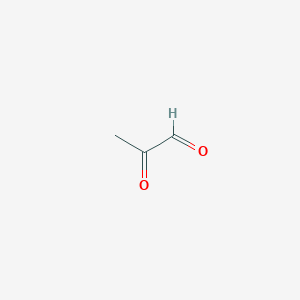| General Information of MET (ID: META00073) |
| Name |
Pyruvaldehyde
|
| Synonyms |
Click to Show/Hide Synonyms of This Metabolite
1,2-Propanedione; 1-Ketopropionaldehyde; 2-Keto propionaldehyde; 2-Ketopropionaldehyde; 2-Oxopropanal; 2-Oxopropionaldehyde; 2-oxo-Propionaldehyde; Acetylformaldehyde; Acetylformyl; Aldehyde, pyruvic; CH3COCHO; Ketopropionaldehyde; Methylglyoxal; Oxopropanal; Propanedione; Propanolone; Pyroracemic aldehyde; Pyruvic aldehyde; alpha-Ketopropionaldehyde
|
| Source |
Endogenous;Escherichia Coli Metabolite;Yeast Metabolite;Food;Drug;Food additives;TCM Ingredients;Microbial
|
| Structure Type |
Carbonyl compounds (Click to Show/Hide the Complete Structure Type Hierarchy)
Organic oxygen compounds
Organooxygen compounds
Carbonyl compounds
|
| PubChem CID |
|
| HMDB ID |
|
| Formula |
C3H4O2
|
| Structure |
<iframe style="width: 300px; height: 300px;" frameborder="0" src="https://embed.molview.org/v1/?mode=balls&cid=880"></iframe>
|
 |
|
3D MOL
|
2D MOL
|
|
Click to Show/Hide the Molecular/Functional Data (External Links/Property/Function) of This Metabolite
|
| KEGG ID |
|
| DrugBank ID |
|
| ChEBI ID |
|
| FooDB ID |
|
| ChemSpider ID |
|
| METLIN ID |
|
| Physicochemical Properties |
Molecular Weight |
72.06 |
Topological Polar Surface Area |
34.1 |
| XlogP |
-0.4 |
Complexity |
55.9 |
| Heavy Atom Count |
5 |
Rotatable Bond Count |
1 |
| Hydrogen Bond Donor Count |
N.A. |
Hydrogen Bond Acceptor Count |
2 |
| Function |
Pyruvaldehyde is an organic compound used often as a reagent in organic synthesis, as a flavoring agent, and in tanning. It has been demonstrated as an intermediate in the metabolism of acetone and its derivatives in isolated cell preparations, in various culture media, and in vivo in certain animals.
|
|
Regulatory Network
|
|
|
|
|
|
|
|
|
 click to show the details of this protein
click to show the details of this protein
 click to show the details of experiment for validating this pair
click to show the details of experiment for validating this pair
 click to show the details of this protein
click to show the details of this protein
 click to show the details of experiment for validating this pair
click to show the details of experiment for validating this pair

